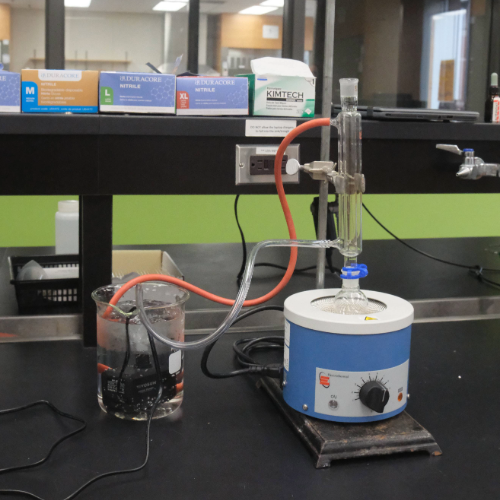We use cookies on this site to enhance your experience.
By selecting “Accept” and continuing to use this website, you consent to the use of cookies.
Search for academic programs, residence, tours and events and more.
Oct. 10, 2024
Print | PDFScience and research labs at Wilfrid Laurier University have reduced water consumption by 98% and energy consumption of high-draw equipment by 30% by introducing new, more environmentally sustainable lab practices and processes.
“Labs are fairly energy-intensive spaces,” says Gena Braun, research instrumentation technician in Laurier’s dean of science office. “On average, a lab will use four times the water of a comparable office space and up to 10 times the energy.”
Waste generated from single-use consumables like personal protective equipment can also contribute to a lab’s outsized environmental footprint. That waste, including plastics, is what led Braun to partner with not-for-profit organization My Green Lab.
“The tipping point for me was seeing a garbage can full to the top with plastic tubes,” says Braun. “So we decided to try out My Green Lab as a pilot project in the Centre for Cold Regions and Water Science (CCRWS).”
My Green Lab provides actionable ways to make meaningful changes in the lab by offering education and recommendations across 14 areas including recycling, water, cold storage and field work. Organizations can implement recommendations that meet their specific budgets and needs, or areas with the highest impact.
My Green Lab has been recognized as a key in the race to zero carbon initiative by the United Nations. The program has been implemented at McGill University and the University of British Columbia, as well as by industry leaders including AstraZeneca.
Braun found a recycling partner who could take some of the CCRWS’s specialized waste. Between September 2023 to June 2024, the centre sent over 50 kg of plastic waste to a nearby recycler. She also initiated a “chill up challenge” on the lab’s freezers.
“One ultra-low freezer operating at –80 degrees can use as much energy as the average home every day,” says Braun.
Using research provided by My Green Lab, as well as information from other institutions, Braun determined the CCRWS could reduce freezer energy consumption by 30% by increasing the temperatures by just 10 degrees.
After the success of the My Green Lab partnership, Braun received a grant from the Sustainable Hawk Fund to expand the partnership to seven additional labs at Laurier.
The undergraduate chemistry lab runs experiments as part of the chemistry and biochemistry programs, welcoming 1,000 students into the lab every two weeks. Senior lab coordinator Sherilyn Van De Wynckel was looking for ways to reduce the water required for these experiments and was excited to undertake the My Green Lab certification process.
“This is something that we’ve looked at in the past,” says Van De Wynckel. “But either it's been too expensive to replace some of the equipment or the procedures wouldn't work with the equipment that we have.”
With guidance from My Green Lab, Van De Wynckel focused on changing two specific processes. The first was the use of water aspirators, which utilize a high-pressure water source to produce a vacuum that allows researchers to suction liquid from a solid. They replaced the water aspirators with a vacuum pump and no longer use water in the process. The second was distillation and refluxing, where a steady stream of cold water is circulated through condenser tubing. Typically, water went from the tap, through the experiment and because it never contacted chemicals, then went down the drain. The undergraduate chemistry lab purchased a submersible circulating water pump and now recycles water in a loop for these experiments.

The changes have proven extremely successful and reduced water consumption by an astonishing 98%.
“Looking at the industry average water usage for those condensers and aspirators, I was able to calculate based on the number of students we have and the number of experiments that we run that we were using approximately 157,000 litres of water per year,” says Van De Wynckel. “By simply changing to vacuum pumps and water pumps, we've been able to reduce that to approximately 2,000 litres.”
Braun is excited by the results of the expanded My Green Lab project because it supports sustainability efforts already taking place at the university and has a direct impact on students.
“Students are very aware of the waste being produced because they’re the ones working in the lab,” she says. “By making these small impactful changes, we’re training future scientists to be green scientists. So when they go off into the field, they can take this knowledge with them.”